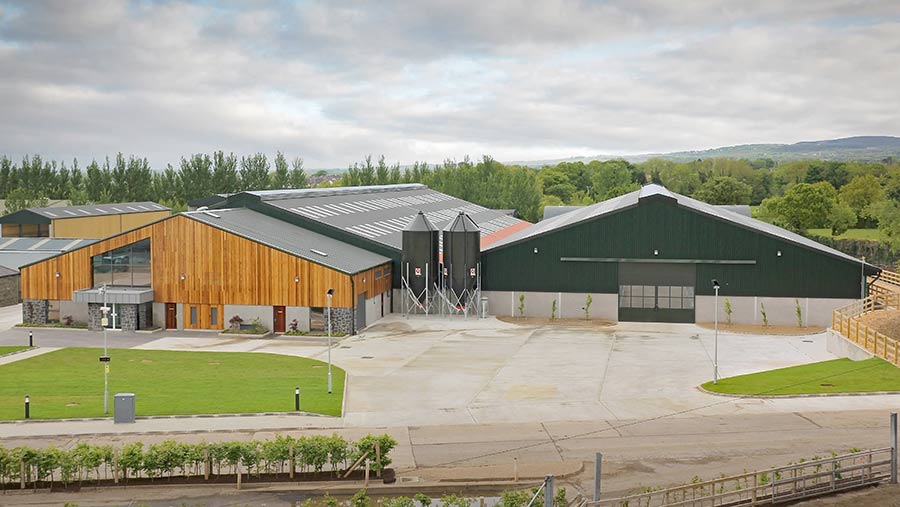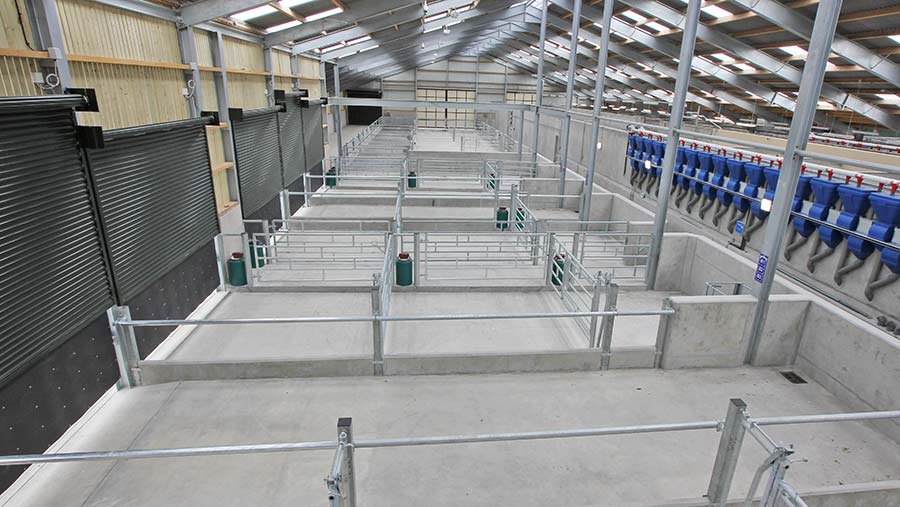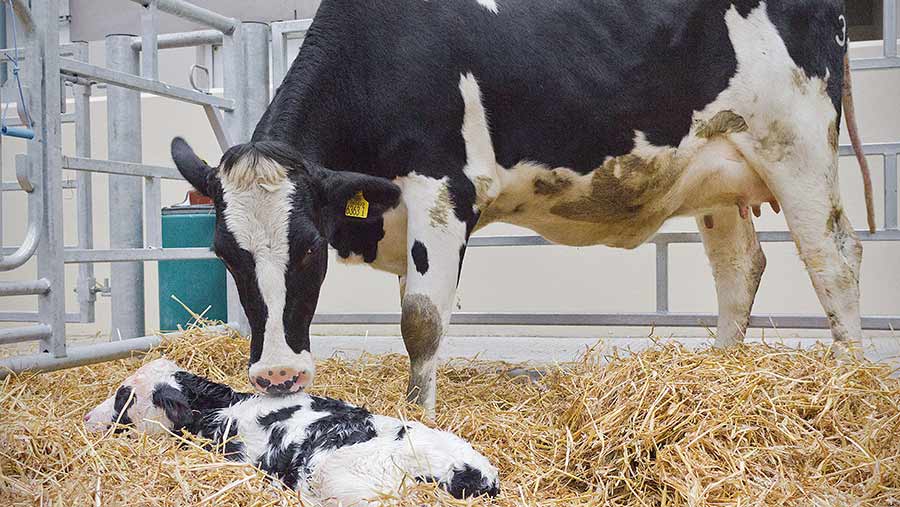How £2.5m dairy unit is improving dry cow management
Good management during the dry period is crucial to promote cow welfare and ensure the profitability of dairy cows in the following lactation.
The College of Agriculture Food & Rural Enterprise (Cafre) in County Antrim, Northern Ireland, has invested £2.5m in a new dairy unit.
It includes a state-of-the-art dry cow and maternity unit.
See also: What’s in Your Livestock Shed? visits a state-of-the-art £1.3m dairy unit
Farm facts
Cafre dairy unit – Greenmount campus
- 200 Holstein cows
- Calving September to April
Alistair Boyle, Cafre dairy technologist, gave Farmers Weekly a grand tour and explained how this dedicated area has helped to increase cow comfort, reduce lameness incidences and improve fertility.

© Alan Hopps
Housing
The maternity area comprises the following features, all implemented with both ease of use and cow comfort in mind.
- Two straw-bedded 8×9.5m pens – for pre and post-calving
- A hospital pen of the same size for any cows needing treatment
- 12 individual calving pens (four rows of three) – fitted with locking head yokes
- A 4x12m sand-bedded communal recovery pen
- Rubber-grooved flooring
- Heated drinking bowls to protect against frost
- A vacuum line to facilitate in-pen colostrum milking
- A winch beam to enable easy lifting of downer cows

© Alan Hopps
The cows are housed for five to seven days either side of calving and are moved into an individual pen for calving. After calving they are moved into a recovery pen for a minimum of five days to allow the cow to fully recover before joining the milking herd again.
Benefits
Features such as the winch beam, the in-pen colostrum milking and the head yokes all help to increase cow comfort and keep the maternity unit as stress-free as possible, explains Mr Boyle.
“After calving, the cow is put in the yoke and given an energy drink to help boost her recovery. At the same time, we milk her in the pen to ensure the colostrum gets to the calf as soon as possible.
“The whole procedure involves minimal movement and disruption, which minimises stress and subsequently helps the cow recover quicker.”
Research has also shown that heifers can go for 24 hours without lying down after calving, so the move to a communal pen after giving birth can help take the weight off their feet, he adds.
He believes this has contributed to a reduction in the incidence of lameness and a lower replacement rate, with older cows staying in the herd for longer.
Currently 90% of cows are rated scores 0 or 1 for lameness.
Feeding
A specific focus has been placed on body condition scoring, predominately in the eight to 12 weeks before drying off.
Dry cow groups are then split into two feeding groups – close-up and far-off – and are fed based on Dietary cation-anion balance (DCAB) principles to minimse health risks.
Far-off cows receive:
- Dry cow minerals
- Round-bale silage (specifically low in potassium)
Close-up cows receive:
- 8kg round-bale silage (specifically low in potassium)
- 10kg wholecrop wheat
- 2kg chopped straw
- 1kg soya
- 100mg magnesium chloride
- 50g dry cow mineral
Cows also get 1.5kg of pre-calver minerals and depending on the overall dry matter of the diet, water is added at a rate of four litres a cow.
One week before calving, cows are fed the same concentrates and forages as the milking cows – feeding up to 2kg of concentrate pre-calving.
Benefits
Altering the diet the week before calving allows the cow’s rumen to adapt to higher levels of concentrate feeding after calving, as well as reducing stress.
The focus on nutrition and altering the diet to match cow requirements also minimises the risk of metabolic diseases – such as milk fever – post calving.
In 2017-18 the herd only had a 2% incidence of milk fever and just 3.5% suffered from retained foetal membranes.
Breeding and fertility
Replacement heifers are bred from sires selected primarily on profitable lifetime index and a number of individual traits, including milk protein, fertility, lifespan and somatic cell count.

© Alan Hopps
However, even with the best genetics, a poor environment will contribute to reduced fertility. The inclusion of features such as grooved rubber matting at feed areas and the improved comfort in the accommodation has increased cow health and bulling activity. This has helped to improve fertility.
Benefits
Submission rates are about 80% – meaning cows are coming back round in a good, healthy condition to be eligible for service.
The conception rate is lower at about 36%, however this is an area they are looking to improve in the coming years, explains Mr Boyle.
Switching to dry cow therapy
Over the past three years, the herd has also been making a shift from blanket treatment to selective dry cow therapy.
The initial criteria for cows to receive antibiotics dry cow therapy, along with internal teat sealants, set in 2016, were:
- Somatic cell counts (SCC) below 150,000 for the past three milk recordings before drying off
- No cases of clinical mastitis during the lactation
Applying these criteria reduced dry cow therapy by 50% in cows that were available for the selection process.
After reviewing results from the first season, the selection criteria were changed, meaning cows only received dry cow antibiotics if somatic cell counts were above 200,000 in any of the past three milk recordings and/or the cow had a case of clinical mastitis during the same period.
Currently 30% of cows are receiving dry cow antibiotics, but all cows are receiving internal teat sealants.
Dry cow antibiotics use in the herd has subsequently been reduced by 70% as a result of implementing selective dry cow therapy.
